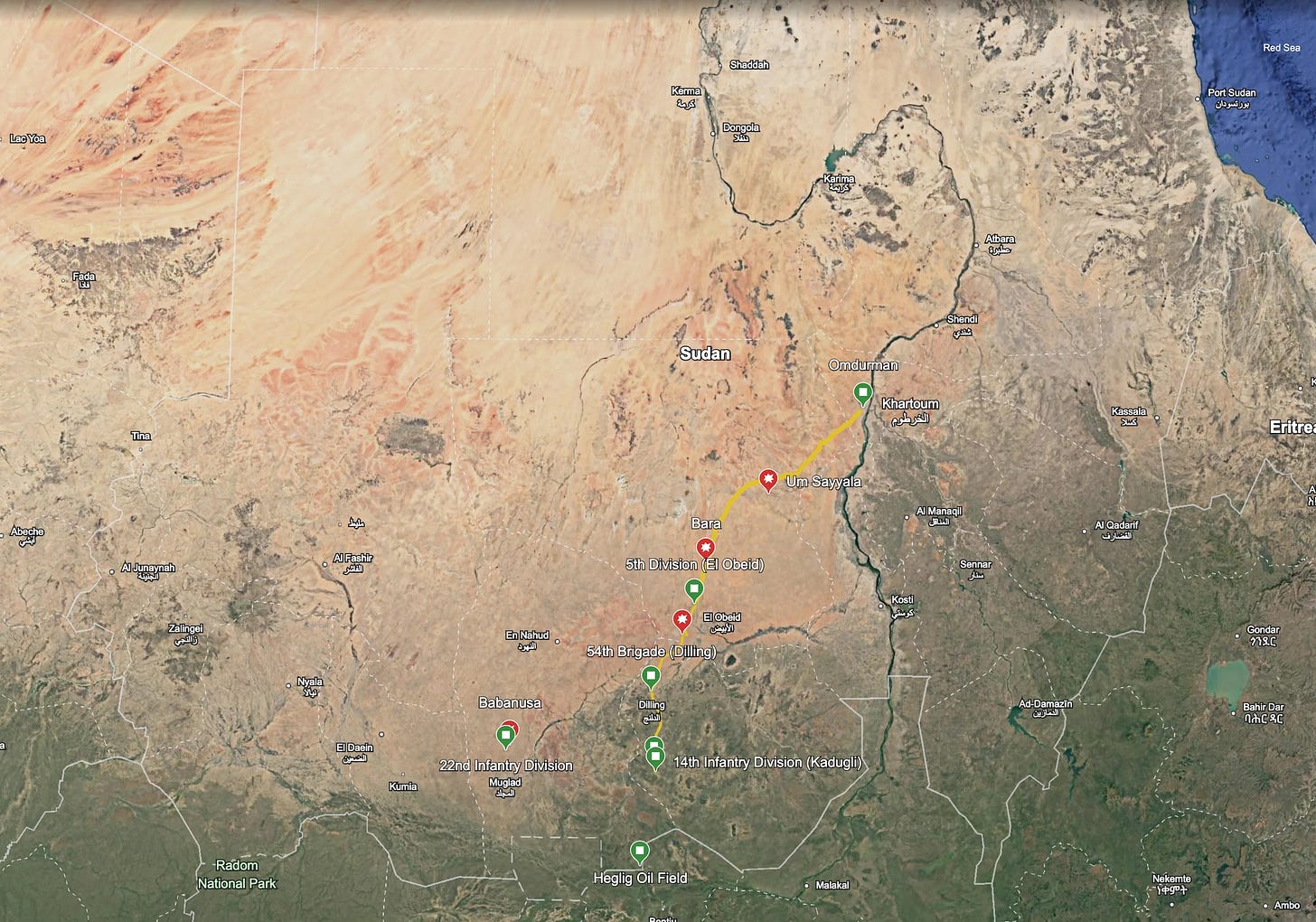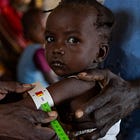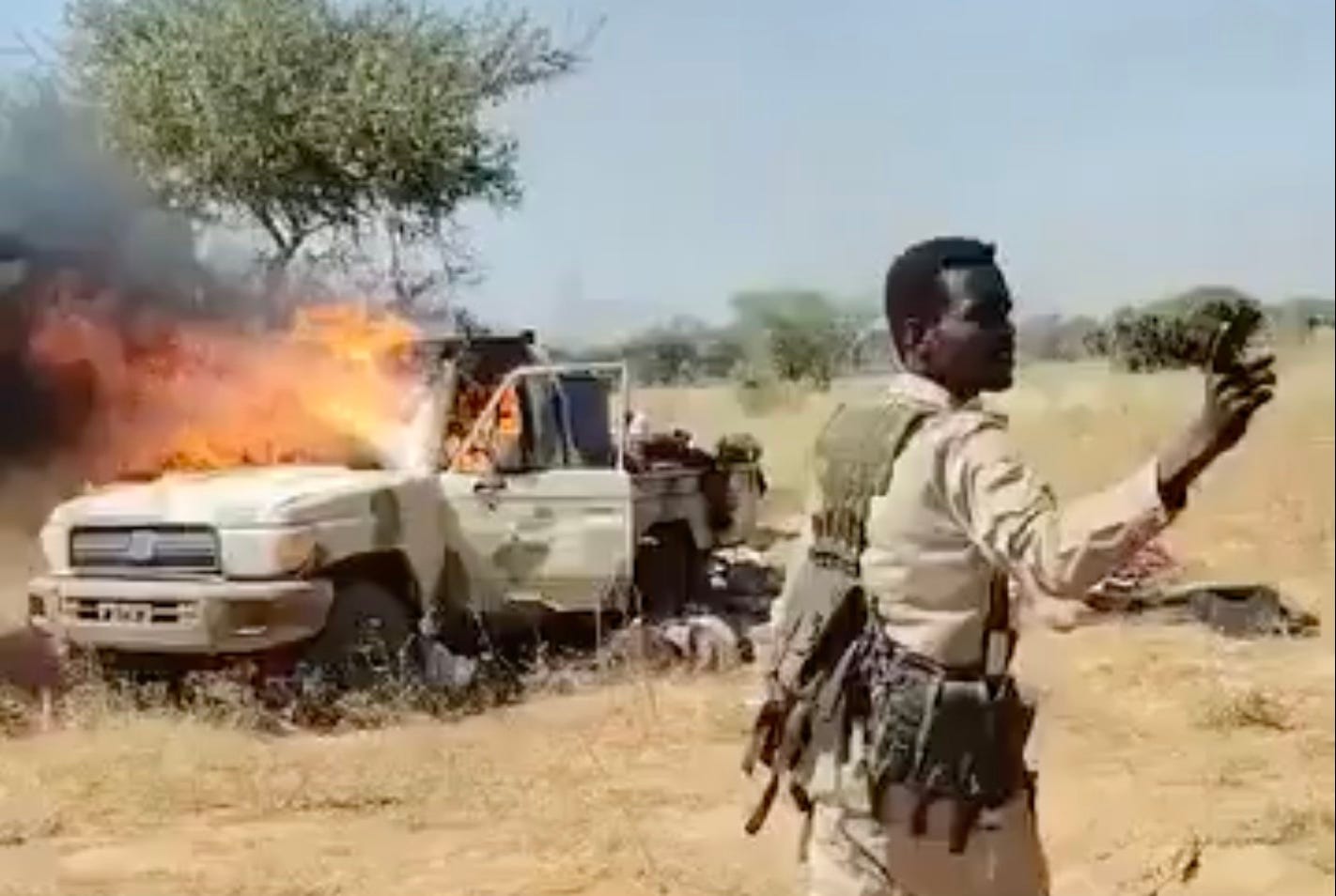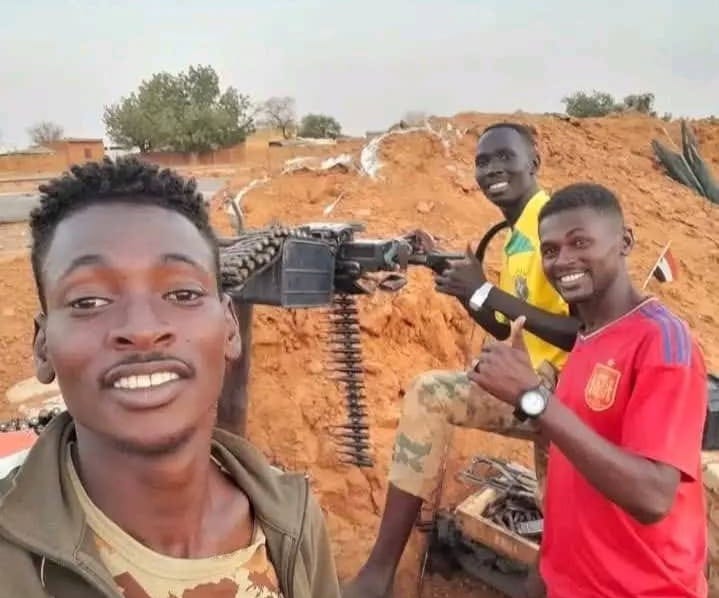Widespread Fighting Engulfs Kordofan Region
Heglig oil flows interrupted; key highway threatened; Babanusa besieged
Video: Wildfire in North Kordofan, Sudan, following clashes, November 19, 2025. Filmed by pro-SAF fighters (SWM Monitoring).
The three states of the Greater Kordofan region have witnessed some of the heaviest fighting of the year, as the Rapid Support Forces (RSF) and the Sudanese Armed Forces (SAF)—supported by the Joint Force movements of Darfur and allied militias—clashed on multiple fronts.
The fighting involves both sprawling mobile warfare on the plains of North Kordofan, and intense urban combat in the besieged city of Babanusa. The latest escalation follows the RSF’s seizure of the Sudanese army’s 6th Infantry Division in El Fasher, North Darfur’s capital, late last month, freeing substantial RSF manpower for redeployment into Kordofan.
The fighting has left an unknown but evidently large number of casualties across several fronts, with both sides reporting significant losses in men and equipment amid some of the heaviest engagements seen in Kordofan in a year or more. Among the wounded is pro-SAF paramilitary commander Abu Aqla Keikel, leader of the Sudan Shield Forces.
Unfamiliar with the conflict? Start here:
The Sudanese military and its allies on Monday and Tuesday pushed west from White Nile State toward Umm Sayyalla while other units advanced northward from El Obeid and Umm Dam locality into Bara, entering both towns briefly. These two simultaneous operations suggest a coordinated effort to reopen the road between El Obeid and Omdurman/Khartoum. Videos reviewed by Sudan War Monitor show Joint Force and Sudan Shield fighters arriving on the outskirts of the two towns.
Below: SAF troops arriving in Bara, North Kordofan, November 17, 2025. They held the town only briefly before withdrawing.
The RSF quickly counterattacked, forcing the army and its allies to retreat into open terrain in both areas where the allied forces suffered major casualties, as confirmed by videos posted on pro-RSF social media accounts.

Um Sayyalla is a small village of minimal strategic value on its own. But its location in the far northeast of Kordofan, near the White Nile State border, and its proximity to the highway to Khartoum, indicate that RSF forces can operate close to this key supply route. Bara is similarly positioned along the same highway, which holds both military and economic importance.
SAF needs to clear RSF units from its rear areas before it can effectively resume its westward offensive and relieve the sieges of Kadugli, Dilling, and Babanusa. Its failure this week to hold key locations along Kordofan’s main north-south highway casts doubt on its ability to supply and reinforce these more remote outposts. However, the fighting is not yet over; sustained SAF attacks eventually could dislodge the RSF from eastern Kordofan.
Videos: SAF-allied fighters operating in North Kordofan, 17 Nov 2025.
After the SAF withdrawal from Um Sayalla, the RSF issued a statement describing what it called a decisive engagement in the area, where it claimed to have destroyed a full military column and inflicted heavy casualties. The RSF described its pursuit of retreating forces toward White Nile State and said its fighters were maintaining readiness for further operations.
“The valiant Rapid Support Forces on Monday achieved a sweeping victory over the army of the ‘Islamic Movement terrorists’ and the mercenaries of the armed movements in the Umm Sayyalla area of North Kordofan State, destroying an entire military column and pursuing the fleeing remnants all the way to the outskirts of Al-Alga in White Nile State.”
“Our brave forces fought a decisive battle that ended with inflicting heavy losses on the enemy, including more than 470 killed, in addition to seizing over 60 combat vehicles fully equipped with weapons and ammunition, and destroying more than 30 vehicles. The operation crushed any ambitions the remnants [SAF] had of taking control of the area…”
Sudan War Monitor is unable to verify these casualty figures, beyond general confirmation of losses on both sides. Sudan’s warring parties tend to exaggerate the enemy’s losses, while remaining silent about their own losses.
The Sudan Shield Force, whose leader Abu Aqla Keikel defected from the RSF in 2024, also acknowledged that Keikel was injured in Umm Sayyalla. The group said the operation had been part of a coordinated plan with the SAF to degrade RSF capabilities along the North Kordofan axis. The statement emphasized the heavy fighting and multiple waves of RSF reinforcements, saying its forces had fulfilled their objectives despite sustaining casualties.
“On Monday, 17 November 2025, the Sudan Shield Forces carried out a successful combat mission in the Umm Sayyalla area of North Kordofan, as part of the integrated national effort alongside the Sudanese Armed Forces and supporting forces against the ‘Dagalo militia’ terrorist group [RSF]. The operation fell within a comprehensive military plan prepared by the Armed Forces to eradicate the rebellion and completely destroy its capabilities along the North Kordofan axis—beginning with the Umm Sayyalla area as the first phase.”
“Our forces fought with valor in executing the mission and fulfilled their role as required, inflicting heavy losses on the enemy in lives and equipment, despite the militia’s massive presence in the main battle and its repeated reinforcements in three successive ground waves, supported by drones and heavy artillery. By the grace of God, the operational objective was achieved by breaking the enemy’s strength and destroying its human and material capabilities in the area, including vehicles and weapons—laying the groundwork for subsequent operations and facilitating the tasks of the forces in the next phases.”
“Our forces have counted a number of martyrs, wounded, and missing in this major and fierce operation, an expected outcome for this type of combat mission. We ask God to accept our martyrs, grant the wounded a speedy recovery, and return the missing safely. Among the injured was our forces’ commander, who personally led the battle; he sustained a minor injury, received immediate medical care, and—thanks to God—continued his duties until the battle was completed, with the enemy defeated and prevented from achieving its objectives….”
New fighting also broke out northwest of El Obeid on Tuesday morning, after the Sudanese military, assisted by units from the Joint Force, attacked Jebel Abu Sinun, a terrain feature that has shifted hands repeatedly during previous fighting in North Kordofan. Joint Force soldiers posted videos showing destroyed RSF vehicles, while the RSF claimed in a statement that it destroyed the SAF column that attacked the area.
This is the second time since September that the Sudanese army attacked the area but was repulsed by the RSF. The same pattern of attacks was also observed in Kazgil, where the RSF said it repelled an SAF assault. Footage verified by Sudan War Monitor shows RSF units filming from inside Kazgil, ending speculations that the SAF was in control for the last two months.
The town lies along the road between El Obeid and Dilling/Kadugli, indicating that the SAF likely have difficulty moving troops and supplies toward these besieged cities to the south, where the RSF have formed an alliance with the Sudan People’s Liberation Movement (North), and rebel group that has controlled parts of the Nuba Mountains for decades.
According to human rights monitors, some civilians in affected areas of North Kordofan have encountered difficulties leaving the state. Fighters have blocked main roads and confiscated mobile phones at checkpoints.
RSF Try to Overrun Army Base in Babanusa
The RSF has intensified its attacks on Babanusa in West Kordofan where the Sudanese military’s 22nd Infantry Division has been besieged since start of the war. The RSF has gradually tightened pressure around the division headquarters since June, and newly redeployed fighters from El Fasher appear to have strengthened the assault. Of the three besieged cities in Kordofan, Babanusa is the most vulnerable; it has the smallest SAF garrison and faces the most intense RSF attacks.
SAF’s recent efforts to resupply Babanusa by air have failed after the RSF shot down an Ilyushin cargo plane west of the city. This raises the prospect that the defenders in Babanusa could run out of ammunition, food, and medical supplies. Military sources told Sudan War Monitor revealed that the Rapid Support Forces attempted to entice Colonel Hassan Darmot, commander of the 89th Brigade, to surrender the brigade to their forces.
The offer included promoting him to the rank of major general, appointing him as commander of the 22nd Division, granting him a large sum of money, and providing him with a house in an unspecified foreign country. The commander reportedly rejected the offer, allowing a 72-hour ultimatum to expire, after which the RSF launched a major attack.
Videos of this fighting reviewed by Sudan War Monitor show RSF soldiers attacking the 89th infantry brigade in Babanusa from the northeast while coming under automatic fire. One recording captures an RSF soldier identifying the main administrative buildings of the base, suggesting the siege has tightened significantly.
The RSF claims that the 22nd Infantry Division is now under “complete siege” and that it has overrun several forward positions, while SAF insists the garrison will hold out and is repelling attacks. Communications from Babanusa have been intermittent.
Heglig Oil Field Attacked
In the days leading up to the RSF’s latest ground assault on Babanusa, the militia carried out a drone strike on the Heglig airstrip, one of several recent aerial attacks targeting SAF infrastructure in West Kordofan.
Heglig is a critical transit point for crude flowing from South Sudan’s Unity and Tharjath oilfields toward Port Sudan, and disruptions there have immediate economic implications for Juba.
Following a similar RSF strike in August, Sudan’s oil ministry formally notified South Sudan that the pipeline would be shut down due to insecurity, briefly halting exports.
South Sudan relies on oil revenues for over 90 percent of its fiscal budget, and repeated interruptions—combined with the country’s ongoing internal economic and political instability—have left its petroleum sector increasingly fragile and prone to operational stoppages.
Fighting near South Kordofan capital
Fighting also flared west of Kadugli, the capital of South Kordofan State, where SAF forces launched an offensive on Borno, an area previously held by SPLM-North. Pro-army videos show SAF fighters celebrating in the area, though SPLM-North has not issued a statement.
SAF also claimed to have captured positions in Jebel Abu Sinun, which straddles the northern edge of South Kordofan. The army issued a lengthy statement describing what it called coordinated advances in several axes across Greater Kordofan and attributing the momentum to the morale of its troops and the support of the population.
“The Sudanese Armed Forces today achieved a significant advance across all Kordofan axes, following heroic battles fought by its formations—including army units, joint forces, and support forces. They successfully carried out their missions with high efficiency, inflicting heavy losses in lives and equipment on the “Dagalo militia” terrorist group, while securing several vital positions and redeploying according to the established plan.”
“Your Armed Forces affirm that operations are progressing based on precise assessments, and that the spirit and morale of the fighters are at their highest levels—by the grace of God, and through the trust and continued support of the Sudanese people.”
“We assure our honorable people that the march toward victory is advancing, God willing, with the steadfast will of our heroes, until the country is completely cleansed of rebellion and treachery.”
“We pray for paradise and eternity for our martyrs, a swift recovery for the wounded, and the safe return of our prisoners.”
“Victory is from God, and a conquest is near.”
The RSF, however, issued its own account of the southern fighting, claiming to have inflicted heavy casualties on SAF and allied forces in multiple areas west of El Obeid. The group described its operations as part of a broader push to eliminate the remaining “strongholds” of the army and its affiliates.
The statement said in part,
“On Tuesday, our valiant fighters inflicted humiliating defeats on the terrorists and their mercenary militias in the areas of Jebel Abu Sunun, Jebel Isa, and Al-Ayyara, west of El Obeid, bringing an end to what they described as their reckless adventures. Our forces inflicted heavy losses on the enemy, amounting to hundreds of killed, in addition to seizing large quantities of weapons, equipment, and dozens of combat vehicles…”
Overall, the Kordofan region is roughly the same size as Germany. It is subdivided into three states and has a population of more than six million. Its main economic activities include agriculture and pastoralism, gold mining, and the production of gum arabic—a high-value forestry product used in soft drinks such as Coca-Cola, as well as in pharmaceuticals and cosmetics.




